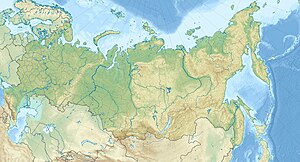Ket people
 |
|
| Total population | |
|---|---|
| (ca. 1,600) | |
| Regions with significant populations | |
| Krasnoyarsk Krai (Russia) | |
|
|
about 1,500 (2002) |
| Languages | |
| Ket, Russian | |
| Religion | |
| Russian Orthodoxy, Animism, Shamanism | |
| Related ethnic groups | |
| Yugh people | |
| Location | Most Ket live on the middle Yenisei River and tributaries, including a group in the community of Kellog. |
|---|---|
| Coordinates | 62°29′N 86°16′E / 62.483°N 86.267°ECoordinates: 62°29′N 86°16′E / 62.483°N 86.267°E |
Kets (Russian: Кеты; Ket: Ostygan) are a Siberian people who speak the Ket language. In the Russian Empire, they were called Ostyaks, without differentiating them from several other Siberian peoples. Later they became known as Yenisey ostyaks, because they lived in the middle and lower basin of the Yenisei River in the Krasnoyarsk Krai district of Russia. The modern Kets lived along the eastern middle stretch of the river before being assimilated politically into Russia between the 17th and 19th centuries. According to the 2010 census, there were 1,220 Kets in Russia.
The Ket are thought to be the only survivors of an ancient nomadic people believed to have originally lived throughout central and southern Siberia. In the 1960s the Yugh people were distinguished as a separate though similar group. Today's Kets are the descendants of the tribes of fishermen and hunters of the Yenisey taiga, who adopted some of the cultural ways of those original Ket-speaking tribes of South Siberia. The earlier tribes engaged in hunting, fishing, and even reindeer breeding in the northern areas.
The Ket were incorporated into the Russian state in the 17th century. Their efforts to resist were futile as the Russians deported them to different places to break up their resistance. This also broke up their strictly organized patriarchal social system and their way of life disintegrated. The Ket people ran up huge debts with the Russians. Some died of famine, others of diseases imported from Europe. By the 19th century the Kets could no longer survive without food support from the Russian state.
In the 20th century, the Soviets forced collectivization upon the Ket. They were officially recognized as Kets in the 1930s when the Soviet Union started to implement the self-definition policy with respect to indigenous peoples. However, Ket traditions continued to be suppressed and self-initiative was discouraged. Collectivization was completed by the 1950s and the Russian lifestyle and language forced upon the Ket people.
...
Wikipedia

